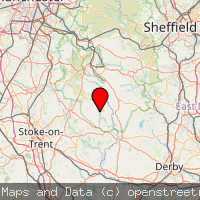Darfar Ridge Cave
Excavation
F.H. Thomas, R. Moore, S. Nicholson, 1960-1; M. Milner 1980-1.
Curation
Stoke-on-Trent Museum.
Burials
MNI: 7 (3 adults, 4 juveniles).
Finds
Leaf shaped arrowhead; microlith; thumb scraper; Romano-British artefacts; animal bones.
Dates
| Period | Reliability |
|---|---|
| Neolithic | Stratigraphical context of human remains indeterminate |
14C
-
Additional Notes
Possibly Late Neolithic in date.
External References
| Derbyshire Cave Registry | 658 |
| National Monuments Record | SK 05 NE 20 |
| Sites and Monument Record | 00369, 04129, 04130, 05033 |
Bibliography
Anon (1993) Keele Archaeology Group Newsletter No 1.
Branigan, K. & Dearne, M.J. (1991) A Gazetteer of Romano-British Cave Sites and their Finds. Department of Archaeology and Prehistory, University of Sheffield.
Green, H.S. (1980) The Flint Arrowheads of the British Isles. B.A.R. British Series 75. B.A.R., Oxford.
Milner, M. (1981) Recent discoveries in the Manifold Valley. Derbyshire Caving Association Newsletter 48: 1-4.
Milner, M. & Johnson, S. (1983) Darfar Ridge Cave. The Manifold Caver 25-28.
Nicholson, S. (1966) The second report on the excavation of Darfur Ridge Cave. Peakland Archaeological Society Newsletter 21: 20-25.
Papakonstantinou, N. (2009) Human Skeletal Remains from Neolithic Caves in the Peak District: an Osteoarchaeological and Taphonomic Approach. Unpublished MSc dissertation, Department of Archaeology, University of Sheffield.
Teather, A. (2022) Linear art in the European Neolithic. In Mazel, A. & Nash, G. (eds) Signalling and Performance: Ancient Rock Art in Britain and Ireland. Archaeopress, Oxford, 282-296.
Thomas, F.H. & Moore, R. (1962) First report on the excavation of Darfur Ridge Cave. Peakland Archaeological Society Newsletter 18: 7-9 & 32.
Trent and Peak Archaeological Trust (1993) Manifold Valley, Staffordshire, Cave Survey. Trent and Peak Archaeological Trust and RCHME.
Article Author Graham Mullan

